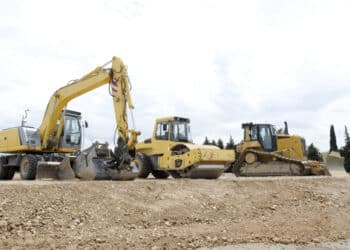Original equipment manufacturers Honda, Moog Construction and Bobcat are working on autonomous vehicles as potential solutions to labor and safety concerns in the equipment industry.
The three companies unveiled their vehicles on March 14, the first day of CONEXPO.
Honda

Honda has unveiled the third-generation Honda Autonomous Work Vehicle, the first model based on an original design, Jason VanBuren, systems engineering manager at American Honda Motor Co., told Equipment Finance News. The previous generations were based on other Honda utility vehicles, such as the Honda Pioneer.
“We don’t need this full suite [like] a car needs, but we still need something that’s extremely safe on a construction site, because there’s a lot of people walking around, there’s debris that falls, there’s obstacles that fall on the ground,” VanBuren said. “It’s good to have access to that type of technology [from Honda].”
Workers in transportation and material moving occupations as well as construction and extraction occupations accounted for 47.4% of all fatal occupational injuries, representing 1,282 and 976 workplace deaths, respectively, according to Occupational Safety and Health Administration.
Customers are “looking for something to help them out from a cost standpoint and a safety aspect,” VanBuren said, noting that the autonomous vehicle is a prototype.
“Pricing is the next major step [for us],” he said. “We’ve got the product at a good price place, now we need to understand what’s the direction we go in from a business standpoint.”
Moog Construction

Moog Construction’s autonomous vehicle is “two to three years away” from being ready for commercialization, said David Chaves, director of autonomy and robotics. Still, the company is evaluating possible applications.
“The secret is going to be to pick the applications where it makes sense,” Chaves said. “If you’re going to pay whatever the number is to put a system on the machine, you don’t want it to be a machine that you’re using four hours a day, you want it to be a machine used 12 hours a day, or 24/7.”
The Elma, N.Y.-based company, a subsidiary of designer and manufacturer Moog Inc., views high-use areas and places with labor shortages as areas of opportunity.
The construction industry needs to attract an estimated 546,000 additional workers to meet labor demands, according to the Associated Builders and Contractors trade association.
“You want [autonomous vehicles] to be in areas where labor is hard to get your hands on,” Chaves said. “If you can pick those kinds of spots, then the price of the autonomous system will pay for itself pretty quickly. [Autonomous vehicles] is an opportunity to continue to grow your market, grow your revenue, that you wouldn’t have otherwise if you were trying to get your hands on all those people.”
Bobcat

Bobcat, a subsidiary of the equipment manufacturing group Doosan Corp., has in the pipeline its all-electric and autonomous compact track loader. The concept vehicle, called the RougeX, debuted alongside the company’s S7X all-electric skid steer loader, which is nearing commercialization.
“We want to evaluate our customers’ perceptions of the ability of this new technology to do real work,” Joel Honeyman, vice president of global innovation at Bobcat, said. The RougeX and S7X also will implement Moog Construction’s TerraTech electrification software, according to a press release. Bobcat previously partnered with Agtonomy to expand its agricultural electrification and automation plans.









